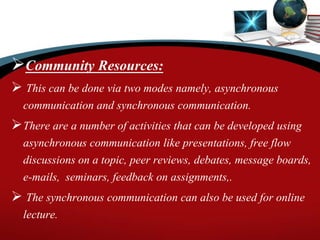Technology in the Teaching Learning Process
- 2. “We need technology in every classroom and in every student and teacher’s hand, because it is the pen and paper of our time, and it is the lens through which we experience much of our world.” David Warlick
- 3. Technology can play a traditional role, i.e. as delivery medium for instructional lessons or in a constructive way as partners in the learning process. Educational Technology is a way for teachers to deliver content to students by using different tools of modern technology.
- 4. Multimedia: Development in computers, communication, electronics and other Multimedia tools provide a wide range of sensory stimuli. Audio-Visuals and Animations: Audiovisuals, video conferencing, short animations, etc can be used in teaching learning process.
- 5. Digital devices: The digital devices like cameras, scanners can be used for instruction. Personal Digital Assistants (PDA): The PDA wireless devices are used as e-learning tools allowing the learners to access information anytime, anywhere. It is observed that, there is a shift from the E-learning to M- learning (which includes learning via. mobile computation).
- 6. Community Resources: This can be done via two modes namely, asynchronous communication and synchronous communication. There are a number of activities that can be developed using asynchronous communication like presentations, free flow discussions on a topic, peer reviews, debates, message boards, e-mails, seminars, feedback on assignments,. The synchronous communication can also be used for online lecture.
- 7. Database: Database is a good source of materials put up by the government, libraries and educational institutions. It contains extensive information on graphic interface, websites, electronic page layout, graphics, multimedia and animated designs.
- 8. Software libraries contain programs that the learners may download to their own computers . The software library includes e-books, interactive CDs and teaching tools.
- 9. Online conversation with parents involved greater discussion about pedagogical issues and often focused on student learning than they had been in traditional school settings. Voice mail and other messaging systems help in encouraging both parents and students to leave messages to their teachers. The parents can also have the direct access to the classrooms instead of having their children’s educational experiences filter and interpreted through the eyes of their children.
- 10. Teachers around the world can share their instructional activities and experiences with each other. The chat rooms like innovative teaching on www.yahoo.com and other websites serve this purpose. The students can decide a time to meet online and discuss the various aspects of the course on weekends and holidays.
- 11. Online testing: The teacher may prepare a question bank or an objective type test and place it on the network. The students answer and submit the test. The immediate feedback and scores can be obtained by the student. The evaluation can be done by means of assignments in the form of presentations, documents, and audio visuals, online quiz in various subjects, etc.
- 12. Role of a teacher in the present era: The starting point of a digital classroom is a teacher. Teachers must be trained to effectively use the technology for planning and student instruction. The role of the teacher has shifted from being the sole 'provider' of knowledge to being a facilitator as the student explores for himself, the expansive world of knowledge. The Learning Management System (LMS) harnesses the potential of technology to improve learning outcomes and to prepare students for the changes in the world in which they live.
- 13. Improve the ways of learning in new learning fashions Working in groups for cooperative and collaborative learning Developing self-learning habits at their own pace and time. Learn with the teacher rather by the teacher. Develop inquiry-learning habits. Review and explore qualitative data. Exchange learning experiences and information with others students and teachers living anywhere in the world.
- 14. Present the material in more interesting and attractive way. Guide and help students in searching the qualitative material. Make best use of time. Coach the students. Provide individualized instruction.
- 15. Direct the students toward cooperative as well as collaborative learning activities. Prepare learning material for students, rather teaching in conventional situations. Diagnose the learning problem of students and help them to overcome. Solve the study problems of students.















